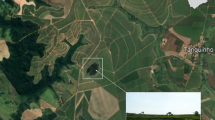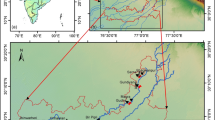Abstract
Multi-electrode resistivity imaging survey with 48 electrodes was carried out to assess the extent of salinity inland, in the shallow subsurface in Nellore district, Andhra Pradesh, in the Eastern Ghats Mobile Belt (EGMB) region. Resistivity data were recorded using Wenner–Schlumberger configuration at nine sites along a profile of about 55 km in length, laid perpendicular to the coast. An average spacing of 6 km is maintained between each site. Assessment of groundwater salinity in the study area was made by joint interpretation of the two-dimensional (2D) geoelectrical models of all the sites together with the geochemical analysis results of water samples and geology. At sites closer to the coast, 2D geoelectrical models of the subsurface indicate low resistivities (2–50 Ωm) in the depth range from surface up to 15 m. Such low resistivities are due to the high salinity of the groundwater. Geochemical analysis results of water samples at six locations close to the electrical resistivity survey sites also suggest high salinity and high concentrations of total dissolved solids and other chemicals at sites closer to the coast. Away from the coast, the resistivities in the depth range from surface up to 15 m vary in the range of 50–150 Ωm. Accordingly, the chemical analysis of water samples collected at these sites also showed relatively low levels of salinity and salt concentrations in them. However, away from the coast, the resistivities vary in the range of 150–1500 Ωm in the depth range from 20–40 m. While the aquaculture and agriculture activities may contribute to high salinity at the sites closer to the coast, the presence of deep-seated paleochannels aiding in transporting seawater inland, and water–rock interactions are suspected to be the chief causes for notable salinity at places away from the coast at shallow depths. We opine that the high salinity at shallow depths, coupled with the deep-seated paleochannels transporting seawater, could pose problems to probe further depths particularly using electromagnetic induction methods in the study region.



Similar content being viewed by others
References
Adepelumi A A 2008 Delineation of saltwater intrusion into the freshwater aquifer of Lekki peninsula, Lagos, Nigeria, Proc. of 3 rd International Conference on Water Resources and Arid Environments and the 1 st Arab Water Forum, 16–18 November 2008, Saudi Arabia, pp. 1–15.
Adepelumi A A, Ako B D, Ajayi T R, Afolabi O and Omotoso E J 2009 Delineation of saltwater intrusion into the freshwater aquifer of Lekki peninsula, Lagos, Nigeria; Environ. Geol. 56 927–933, doi: 10.1007/s00254-008-1194-3.
Babu M M, Viswanadh G K and Rao S V 2012 Assessment of saltwater intrusion along coastal areas of Nellore District, AP; Int. J. Scientific Eng. Res. 4 173–178.
Babu V R R M 2001 Plate tectonic history of the Indian plate, Nellore-Khammam Schist Belt; Indian Acad. Geosci. Publ., pp. 1–183.
Batayneh A T 2006 Use of electrical resistivity methods for detecting subsurface fresh and saline water and delineating their interfacial configuration: A case study of the eastern Dead Sea coastal aquifers, Jordan; Hydrogeol. J. 14 1277–1283.
Central Ground Water Board 2007 Ground water information Nellore District, Andhra Pradesh, Southern Region, Report, pp. 1–37.
Choudhury K, Saha D K and Chakraborty P 2001 Geophysical study for saline water intrusion in a coastal alluvial terrain; J. Appl. Geophys. 46 189–200.
deGroot-Hedlin C and Constable S 1990 Occam’s inversion to generate smooth, two-dimensional models from magnetotelluric data; Geophysics 55 1613–1624.
Ebraheem A A M, Senosy M M and Dahab K A 1997 Geoelectrical and hydrogeochemical studies for delineating groundwater contamination due to saltwater intrusion in the northern part of the Nile delta, Egypt; Ground Water 35 216–222.
Frohlich R K and Urish D W 2002 The use of geoelectrics and test wells for the assessment of groundwater quality of a coastal industrial site; J. Appl. Geophys. 50 261–278.
Frohlich R K, Urish D W, Fuller J and Reilly M O 1994 Use of geoelectrical method in groundwater pollution surveys in a coastal environment; J. Appl. Geophys. 32 139–154.
Loke M H 2001 Electrical imaging surveys for environmental and engineering studies: A practical guide for 2D and 3D surveys, Geotomo Software, Malaysia, pp. 1–67.
Loke M H 2004 Tutorial: 2-D and 3-D electrical imaging surveys; GeotomoSoftware, Malaysia, pp. 1–136.
Rajitha K, Mukherjee C K and Vinu Chandran R 2007 Applications of remote sensing and GIS for sustainable management of shrimp culture in India; Aquacultural Engineering 36(1) 1–17.
Rao N S, Nirmala I S and Suryanarayana K 2005 Groundwater quality in a coastal area: A case study from Andhra Pradesh, India; Environ. Geol. 48 543–550.
Reddy P R and Chandrakala K 2004 Seismicity in and around Ongole, Andhra Pradesh – an appraisal; J. Indian Geophys. Union 8 143–146.
Rönnbäck P, Troell M, Zetterström T and Babu D E 2003 Mangrove dependence and socio-economic concerns in shrimp hatcheries of Andhra Pradesh, India; Environ. Conserv. 30(4) 344–352.
Sasaki Y 1992 Resolution of resistivity tomography inferred from numerical simulation; Geophys. Prospect. 40 453–464.
Schemel L E 2001 Simplified conversions between specific conductance and salinity units for use with data from monitoring studies; Interagency Ecological Program Newsletter 14(1) 17–18.
Acknowledgements
The authors thank the Ministry of Earth Sciences (MoES), Govt. of India, for sponsoring the work through a research project #MoES/P.O. (Seismo)/ 1(69)/2009 to EC. The authors thank D Chandrasekharam for his help in interpretation of geochemical data. EC and DR thank the villagers at Nellore district for their kind cooperation at all the site locations, where the electrical resistivity imaging surveys were carried out. They also thank the staff of Andhra Pradesh State Groundwater Board for providing the geochemical data used in this study. The handling editor Pawan Devangan, Adepelumi, and an anonymous referee have provided valuable reviews that helped to improve the quality of the paper. The authors thank Mr. D Subhakar for his help in drawing figure 1.
Author information
Authors and Affiliations
Corresponding author
Rights and permissions
About this article
Cite this article
Chandrasekhar, E., Ramesh, D., Gurav, T. et al. Assessment of groundwater salinity in Nellore district using multi-electrode resistivity imaging technique. J Earth Syst Sci 123, 1809–1817 (2014). https://doi.org/10.1007/s12040-014-0506-0
Received:
Revised:
Accepted:
Published:
Issue Date:
DOI: https://doi.org/10.1007/s12040-014-0506-0




